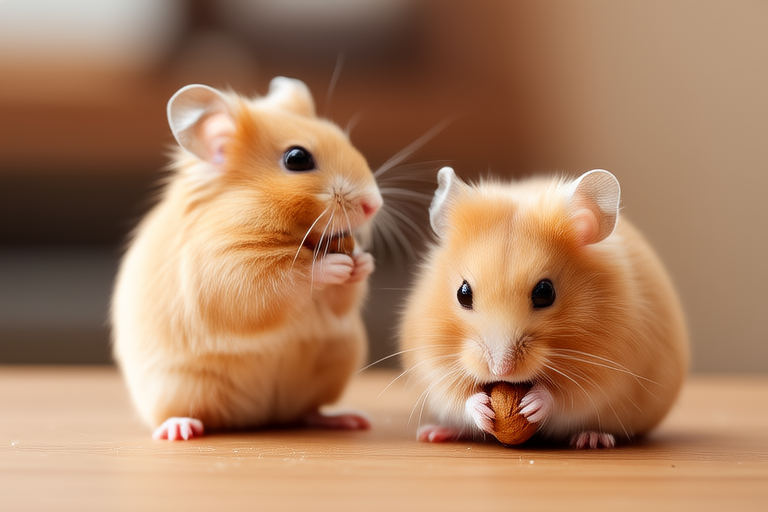Golden Hamsters Unleashed: Fun Facts and Fascinating Behaviors
Welcome to the world of golden hamsters! These adorable, furry creatures have captured the hearts of many as beloved pets. With their soft, golden coats and endearing personalities, they are more than just cute companions; they are fascinating animals with unique characteristics and behaviors that make them stand out from other rodents. In this article, we will delve into the origins, habitats, dietary needs, sleep patterns, social habits, and quirky behaviors of golden hamsters. We’ll also provide tips for caring for your golden hamster and debunk some common myths surrounding these delightful creatures.
The Origins of Golden Hamsters
The golden hamster (Cricetulus auratus) hails from the arid regions of Syria and Turkey. They were first discovered in 1839 by British zoologist George Robert Waterhouse, who named them Cricetus auratus. However, it wasn’t until the mid-20th century that they began to be bred as pets. The golden hamster’s popularity skyrocketed after a single female hamster was captured in Aleppo, Syria, in 1930 and brought to Israel. From this single female, the entire population of domesticated golden hamsters was derived, making them a true testament to selective breeding and genetic diversity.
Typical Habitats
In the wild, golden hamsters inhabit semi-arid regions with sparse vegetation, often digging extensive burrows underground. These burrows serve multiple purposes, including nesting, storing food, and providing protection from predators. When kept as pets, golden hamsters require a spacious cage that mimics their natural environment. A wire or glass enclosure with bedding material like aspen shavings or paper-based bedding is ideal. Adding tunnels, hiding spots, and toys can enrich their living space and encourage exploration and exercise.
Dietary Needs
Golden hamsters are omnivores, meaning they eat both plant and animal matter. Their diet in the wild consists mainly of seeds, grains, fruits, vegetables, and occasionally insects. As pets, they thrive on a balanced diet of commercially available hamster food, supplemented with fresh vegetables and fruits. It’s important to avoid feeding them foods high in sugar, such as chocolate or candy, as these can lead to health issues. Always ensure a constant supply of fresh water, and consider providing a water bottle specifically designed for small animals.
Sleep Patterns
One of the most intriguing aspects of golden hamsters is their sleep behavior. These nocturnal creatures are most active during the night, sleeping for up to 14 hours during the day. During their waking hours, they engage in a variety of activities, including foraging, playing, and grooming. To accommodate their natural sleep cycle, it’s best to handle your hamster during the evening when they are most alert and active. This not only strengthens your bond but also ensures you’re not disturbing their rest.
Social Habits
Golden hamsters are solitary animals by nature, and introducing two adult hamsters can lead to aggressive encounters. However, young hamsters can sometimes be housed together if introduced at a very early age, typically before eight weeks. It’s crucial to monitor their interactions closely and separate them if signs of aggression appear. For most pet owners, keeping a single hamster is recommended, as it provides a safer and less stressful environment for the animal.
Quirky Behaviors
Golden hamsters exhibit several quirky behaviors that make them entertaining to observe. One of their most amusing traits is hoarding food. In the wild, this behavior helps them survive periods of scarcity. As pets, they may stash food in various corners of their cage, even if there’s plenty available. Providing a food dish and regularly cleaning their living area can help manage this tendency without discouraging it entirely. Another notable behavior is their love for running. Many hamsters enjoy using exercise wheels, which provide both physical activity and mental stimulation. Ensure the wheel is large enough to prevent injury and allows for a natural running motion.
Caring for Your Golden Hamster
Proper care is essential for ensuring your golden hamster lives a healthy and happy life. Regular cleaning of the cage, providing a balanced diet, and offering opportunities for exercise are all vital components of good care. Additionally, it’s important to handle your hamster gently and frequently to build trust. Socializing your pet can also include gentle playtime and interaction. Avoid sudden movements or loud noises, as these can startle your hamster and cause stress.
Myths Debunked:
- Hamsters don’t need much space: While hamsters are small, they still require ample room to move around and explore. A spacious cage encourages physical activity and mental stimulation, which are crucial for their well-being.
- Hamsters are low-maintenance pets: Although hamsters may seem easy to care for, they require regular attention, a clean environment, and a proper diet. Neglecting their needs can lead to health problems and behavioral issues.
- Hamsters are always playful: While hamsters are energetic, they also need time to rest. Respecting their sleep schedule and providing a quiet environment during their resting period is essential for their health.
Conclusion
Golden hamsters are captivating creatures with a wealth of unique characteristics and behaviors. From their origins in the Syrian desert to their quirky habits as pets, these small mammals offer endless fascination for animal enthusiasts and pet owners alike. By understanding their dietary needs, sleep patterns, and social habits, you can provide a loving and enriching environment for your golden hamster. Remember, a well-cared-for hamster is a happy hamster, and a happy hamster makes for a joyful companion.
